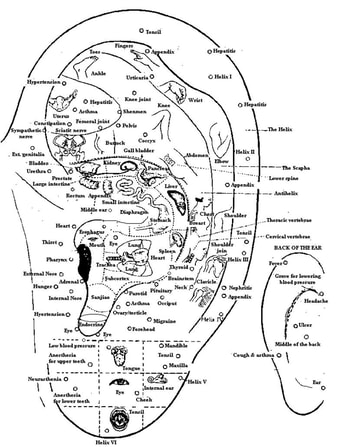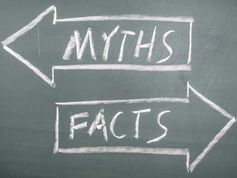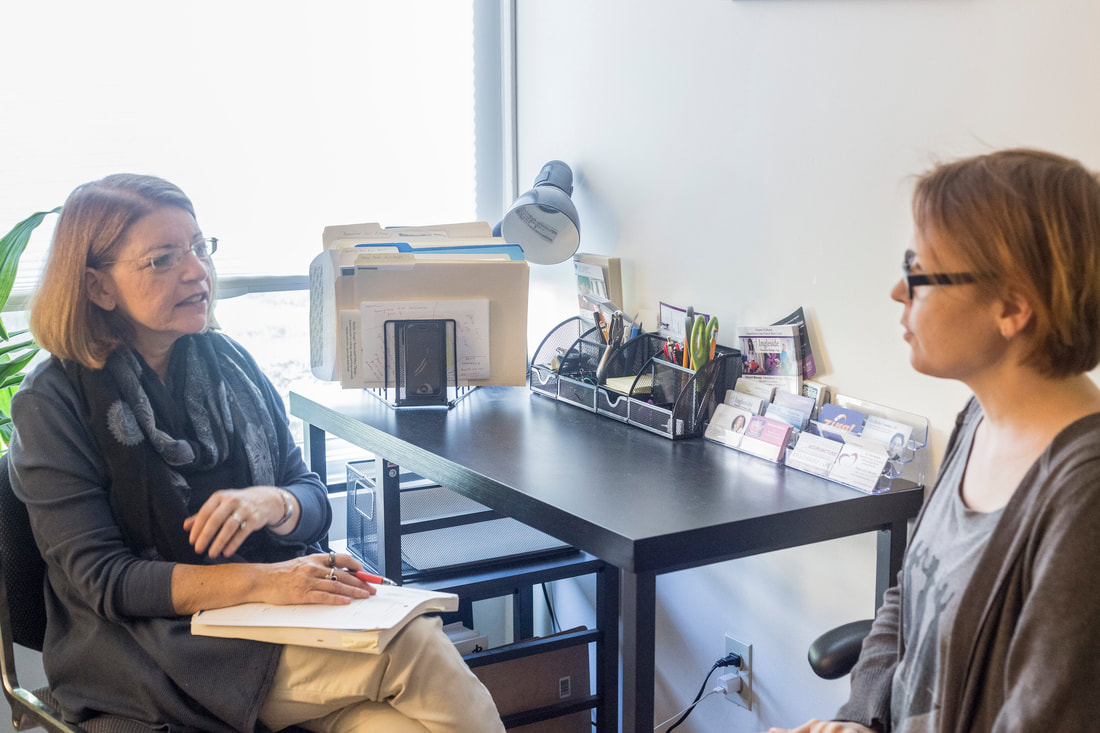 Ear acupuncture is a little different from full body acupuncture in that the ear is considered a microsystem of the body. Although some ear points were mentioned in Chinese texts as far back as 500 BC, auriculotherapy as we know it today was developed by Dr. Paul Nogier, a French physician, in 1957. Dr. Nogier noticed a scar on the upper ear of some of his patients. He found that all of them had been treated for sciatica pain by a local lay practitioner. This woman had cauterized a specific area of the external ear in order to relieve their low back pain. Dr. Nogier conducted a similar procedure on his own sciatica patients and found that their back pain was also reduced. He then tried other means of stimulating this "sciatica point," including the use of acupuncture needles, and found that they too were effective in alleviating sciatica pain. Dr. Nogier theorized that if an area of the upper external ear is effective in treating low back pain, maybe other parts of the ear could treat other parts of the body. Nogier theorized that the ear represents an inverted fetus and points in the ear correspond to parts of the body. Points for hands and feet can be found at the top of the ear, while the face is represented on the bottom of the ear. What’s interesting is that a similar map of the body, called the homunculus, exists in neurons on the cerebral cortex (outermost sheet of neural tissues in cerebrum and some vertebrae), in the thalamus and in the brain stem. This model was first presented to naturopathic practitioners in France in 1957, then spread to acupuncturists in Germany, and finally was translated into Chinese around 1958. During 1958 a large study on the effectiveness of this acupuncture technique was conducted by the Nanking Army Ear Acupuncture Research Team using over 2,000 patients. Dr. Nogier's theory of an inverted fetus was accepted as clinically accurate, and during the cultural revolution so called 'barefoot doctors' were trained in the simple techniques of ear acupuncture In 1990, the World National Organization conducted an international meeting and standardized auricular anatomical names for the points that had been used in Chinese and French auricular acupuncture for many years. By 1995, the World Health Organization, in tandem with the Chinese Government, defined the location of 91 specific ear acupuncture points. Nogier acknowledged that Chinese traditional medicine had been using ear points for acupuncture prior to his discovery, but these had been considered empirical points for particular treatments and were not associated with representation of the homunculus in the ear. This new discovery allowed for greater treatment possibilities. In the US, Terry Oleson who has a PhD in pychobiology published a paper on his research findings. He had 40 patients examined to find areas of their body with musculoskeletal pain. The patients were draped and doctors examined the patients' ears for elevated skin conductivity or tenderness with no knowledge of their medical conditions. The correspondence between the medical diagnosis and the auricular diagnoses was 75.2%. In addition, MRIs show that there is a correspondence between points in the ear, sections of the brain, and areas of the body. Ear acupuncture is a type of treatment that has not only been verified by science, but also leads to clinical success when used to the patients in my office. It works particularly well for pain, addiction and stress!
0 Comments
 Myth 1: Acupuncture Hurts Often, the first thought folks have about acupuncture is that it will hurt. This is not so. The needles that I use are as fine a strand of hair. You may feel a slight pinch when the needle goes in, but afterwards you won't know that they are there. Patients often go into a relaxed state or even fall asleep on the table. Myth 2: Acupuncture is only helpful in treating musculoskeletal pain. While acupuncture is extremely helpful for back, neck, shoulder, shoulder, elbow and knee pain; it's also a great modality for treating asthma, allergies, upper respiratory illnesses, headaches, digestive issues, stress, depression and insomnia. And since it works holistically, you can get relief from a number of seemingly different symptoms all in the same visit. I look at the whole you and bring your body back into balance. It's a one-stop appointment that can help with all of your ailments. Myth 3: Acupuncture could interfere with other modalities Acupuncture is a great complement to other forms of treatment. It helps people to heal from surgery, works in conjunction with Western medicine and can be used in addition to medications. I see myself as a part of my patients' medical team. We are all working together to get you well. So if you have an appointment with your doctor, surgeon, massage therapist or chiropractor; you can get even more relief by receiving acupuncture treatments. |
AuthorIn practice for over 20 years, Bonnie Diamond offers individualized, heart-centered care using a pain-free, Japanese style of acupuncture. Her work is influenced by her nine year struggle with and complete recovery from Chronic Fatigue Syndrome. Archives
April 2024
Categories
All
|
Serving Easthampton, northampton, Holyoke, Springfield, Chicopee, Westfield and Western Massachusetts
|
Hours are Tuesday-Thursday, 11am-7pm
|
247 Northampton Street, #27 Easthampton, MA 01027 781-718-6325 Get directions Get information on other complementary health resources recommended by Staying in Balance. Pioneer Valley Community Resources |
Copyright 2000-2022 All rights reserved.

